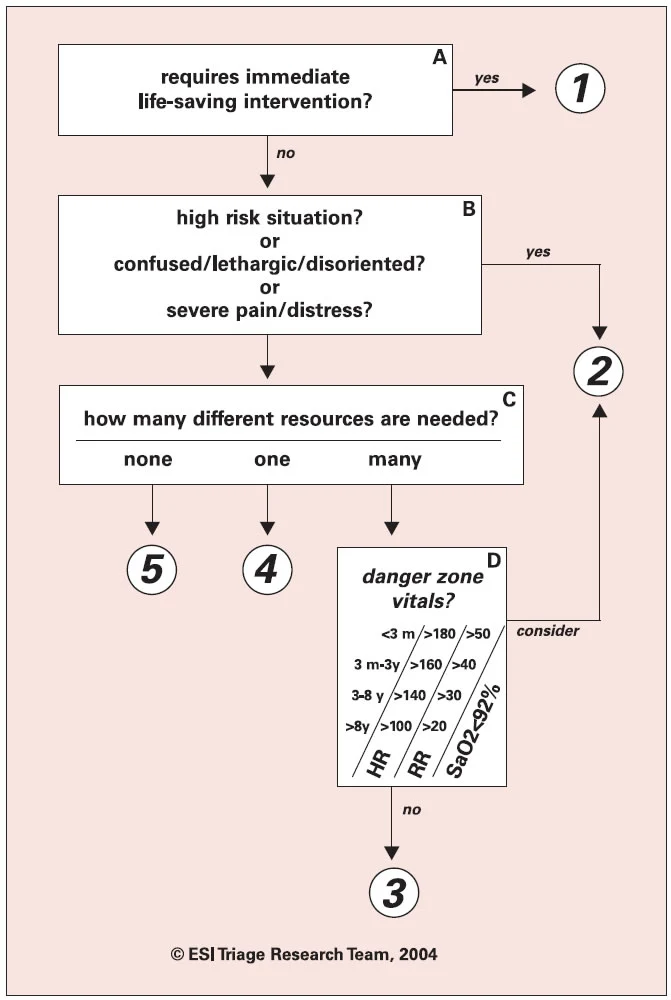
The Emergency Severity Index (ESI) Triage Algorithm is an important tool utilized by nurses when assigning an acuity to the adult patient. The acuity based off of stability of patient, vital signs, potential for threat to life, limb, or organ, and estimated resources needed in treating the patient. Additionally a nurses own experiences, competence, and ability to recognize critical conditions is needed in determining the correct acuity for a patient.
ESI Level 1
Does this patient require immediate life-saving intervention? As a nurse the things that you look for are simple and go back the ABC’s (Airway, Breathing, and Circulation) that you learned way back as a nursing student.
- Is the airway patent?
- Is the patient breathing?
- Is there a pulse?
Examples of level 1 acuity patients:
- Cardiac arrest
- Full trauma
- Unresponsive to painful stimuli
- Respiratory arrest/severe distress
Level 1 acuity patients need treatment immediately in order to save their lives.
ESI Level 2
This acuity level asks the question is the situation high risk, is the patient confused, lethargic, or disoriented, or in severe pain or distress. Patient’s with this acuity level tend to need quick intervention and usually have unstable vitals. These are the patients that light up your nursing intuition that something isn’t right. These patients tend to decompensate quickly without any intervention.
Examples of level 2 acuity patients:
- Chest pain
- Stroke like symptoms
- suicidal/homicidal
- Unstable vitals such as hypo/hypertension, or brady/tachycardia
ESI Level 3
Patients with ESI level 3 tend to make up the majority of the patients that I see in the ER. These patients may require many resources like lab work, imaging, and IV medications, in order to reach a diagnosis and provide treatment. With these patients you have to be able to predict what the ER provider will order for the symptoms that the patient presents with, you must consider patients age, gender, and medical history in determine the amount of amount of resources needed. These patients have stable vitals and are able to wait to see a provider if necessary.
Examples of level 3 acuity patients:
- Abdominal pain
- Headache/migraine
- Fatigue with stable vitals
- Fractured ortho injuries
ESI Level 4 & 5
This category is mostly made up of lower acuity patients that are similar to urgent care patients. These patients require one or no resources in order to provide treatment and obtain a diagnosis. These patients are stable and can wait hours to see an ER provider, especially at a busy hospital. In the hospital I work at we triage these patients to go to our “fast track” setting. This area provides us a opportunity to have the patient see an ER provider and get discharged faster without having to take up a bed in the main ER. This improves patient satisfaction and wait times.
Examples of level 4 acuity patients:
- Sprained wrist
- Uncomplicated UTI
- Laceration
- Abscess
- Sore throat
Examples of level 5 acuity patients:
- Otitis Media
- Conjunctivitis
- Medication refill
- Stitch removal
- Dental pain
An important thing to remember is that the patient acuity can change at any time! So it is important to reassess the patient, re-checking vitals, mental status, pain level etc., in order to ensure that acuity level is still appropriate for the patient. The ability to triage a patient is definitely one that is learned and fine tuned over time and with gained knowledge. I know as a nurse now, that experience does shape your practice and how you will triage. There are patients that I have triaged incorrectly and these patients do stick with you and cause you to modify your thinking when you have other patients present with similar symptoms. From each triage experience, good and bad, you grow and become a better emergency nurse.
